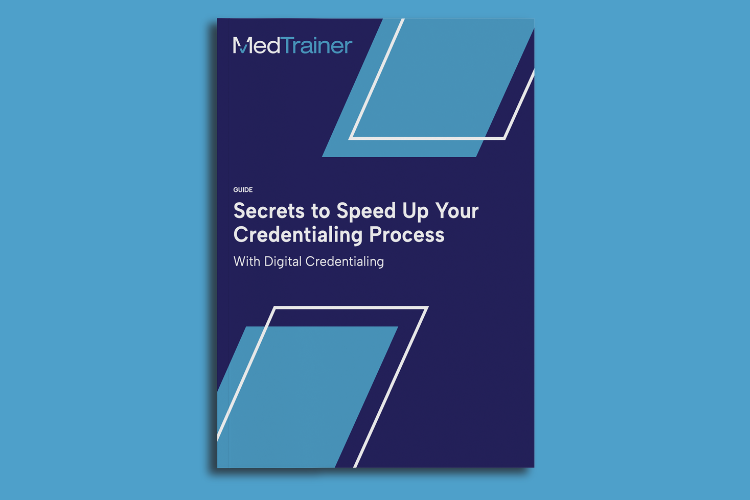With so many details, documents, and moving parts, healthcare credentialing mistakes are inevitable. What matters is the preventative measures you put in place and how quickly you’re able to react when you discover an issue. In this article, we’ll look at the top five healthcare credentialing mistakes with ideas of how to avoid each.
Why Healthcare Credentialing Is So Crucial
Credentialing is the process of verifying that a healthcare provider’s documentation, certifications, and background are legitimate. It is incredibly important to ensure physicians are qualified for the job of providing safe and ethical patient care, along with protecting the healthcare institution itself.
For example, if your hospital grants privileges to someone who doesn’t have enough experience, the resulting damage can lead to costly negligence lawsuits — and no healthcare organization wants to deal with that.
However, as integral as the medical credentialing process is for hospitals, it is by no means an easy task. There are numerous problems that healthcare organizations can encounter that make credentialing a pain to deal with. This is especially true when organizations are understaffed, handling high turnover, or bringing on more providers as part of a growth plan. Being aware of the top healthcare credentialing mistakes can help you and your organization avoid them.
Get secrets to speed up your credentialing process.
Top 5 Credentialing Mistakes in Healthcare
1. Allowing Providers To Start Before Verifications Are Complete
As the purpose of healthcare credentialing is to ensure that a care provider has the right qualifications for their position, letting them start prior to the completion of verification can lead to multiple problems. Overworked hospitals may feel tempted to grant a new provider their privileges as soon as possible, but by doing so, they may be placing the care of their patients in the hands of someone who is not qualified.
In addition to ensuring a practitioner has the necessary experience, hospitals must also collect licensure information, check for exclusions, and perform thorough background checks to avoid accidentally bringing on an individual that has been debarred. Keeping all communication, documents, and information in a centralized place, such as an electronic provider profile, will offer organization to an often chaotic process.
2. Failure to Recredential Current Providers
Recredentialing can sneak up on you if you aren’t tracking dates and expirations. Missing a recredentialing or license renewal deadline is a huge pain as you’ll often have to complete the entire credentialing process over again. Plus, the provider will not be reimbursed for services provided when the credentials were expired. To avoid this healthcare credentialing mistake, you should add a recredentialing reminder as soon as the initial credentialing and enrollment is complete. These reminders should start 90-180 days prior to expiration to ensure providers have enough time to complete all necessary steps.
3. Submitting Incomplete or Incorrect Applications
There is an immense amount of information that healthcare providers must submit on credentialing and enrollment applications, and as a result, they may accidentally leave some information blank. Any incomplete applications will cause delays in the credentialing process and possibly even result in denied claims, further hindering an already lengthy process. Not verifying the completion of the application is a common healthcare credentialing mistake.
Even if an applicant completes all fields, there’s no guarantee that all of it is correct. For example, they may write down incorrect contact information if they’ve recently moved. Payers will not hesitate to send the entire credentialing packet back to correct this type of information.
4. Improper Time Management
Poor time management can prevent a busy hospital from adding new healthcare providers to its staff, resulting in lost revenue and staffing shortages. Even if a credentialer is only allowing a delay of one or two days per task, it can add up over the entire credentialing process. According to Merritt Hawkins, providers bring in about $9,000 per day, so even delaying the process by one week costs an average of $45,000.
Credentialers can keep the process on track by taking advantage of automation offered in credentialing software. Not having to manually check exclusions or remind providers to submit documents can save a significant amount of time. Having a standard checklist for the process will also keep credentialers on track and help to reduce delays between steps.
5. Not Staying Up-To-Date With Credentialing Requirements
Every state and payer has different requirements for credentialing – and the requirements can change at any point. Not paying attention to these changes is a healthcare credentialing mistake that can be avoided. Most payers and states share changes via email and some even offer webinars to ensure credentialers have the latest information. If there are multiple credentialers within your organization, assign one person to be responsible for reading these updates and notifying the team of process and requirement changes.
With countless physicians to keep track of, it can be very difficult for all credentialers to keep up with changes. And even if there are enough people on the credentialing team, the amount of work that must be done can still become incredibly stressful. As credentialing requires attention to detail to avoid errors, accumulated stress can result in mistakes that will cost a healthcare organization time and money.
How Credentialing Software Helps To Avoid Mistakes
Many mistakes made during the credentialing process can be addressed by transitioning your hospital to digital software, which will eliminate human error, streamline the process, and provide other benefits as well. From automated OIG-LEIE and SAM exclusions monitoring to comprehensive provider profiles and reporting, credentialing software can reduce mistakes and the associated delays.
Features to look for:
- Automated Reminders: Don’t miss recredentialing deadlines or waste time manually reminding providers to submit documents.
- Automated Exclusions Monitoring: Keep the credentialing process moving forward with automated OIG, LEIE, and state license verifications.
- Checklists and Workflows: Customize your own checklists or workflows to keep the credentialing process on track.
- Provider Profile: Keep all provider information together in one location where providers can directly upload documents.
- All-In-One: Having primary source verification information, enrollments, and privileging all in one location saves time for busy credentialers.
Think your organization could benefit from credentialing software? Reach out to MedTrainer today to schedule a demo!

